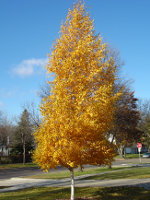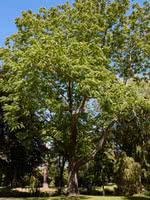Mon-Fri 9am - 5pm Mountain time
Dakota Pinnacle Birch vs Black Walnut
Betula platyphylla fargo
Juglans nigra
CUSTOM GROW
NOT AVAILABLE THIS SEASON - MIGHT RETURN
Dakota Pinnacle Birch is a hardy deciduous tree with a columnar to narrowly pyramidal form. It makes a beautiful accent tree, and Dakota Pinnacle Birch is insect resistant and drought tolerant.
Dakota Pinnacle Birch features smooth white bark and dark, green foliage that turns yellow in the fall.
The Black Walnut is a slow growing, large, straight-stemmed tree with an open crown. It produces dense, very hard, edible nuts.
Black Walnut has a deeply-furrowed, black bark. Its leaves are about 1 foot long, composed of 15 - 23 slightly stalked leaflets on a moderately stout stock which provide good dappled shade.
Despite being highly valued for its edible nuts and its shade tree aesthetics, it is rare to see this tree on the prairies.
Note: Black Walnut's roots produce a substance named juglone that is toxic to some other plants. Consider this when choosing where you plant a black walnut, as you will not be able to grow tomato, potato, cabbage, eggplant, blueberry, azalea, rhododendron, lilac, red pine and apple in the surrounding area.
Note: Plant this tree once. It will not respond well to transplanting.
Note: Although self-pollinating, planting two trees significantly improves nut production.
A top CO2 absorbing species. Experts think this tree may help climate change more than others.
Dakota Pinnacle Birch Quick Facts
Black Walnut Quick Facts
In row spacing: 1.8 - 2.4 m (6 - 8 ft)

